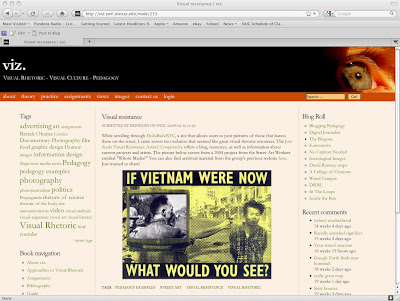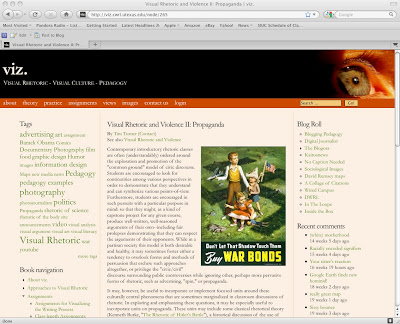Social Sciences
 via viz
via viz
While doing an image search for an unrelated project, I came across this informative blog, vis. Visual Rhetoric, Visual Culture, Pedagogy, from the University of Texas. As the subtitle explains, this blog has a nicely arranged series of posts related to a curriculum I usually refer to as media literacy on my blog. Namely, this curriculum focuses on the creative techniques advertisers, governments, or any other creators of propaganda use to inform or persuade an intended audience.
Granted, at first glance, some of the content found on the viz website might seem "too philosophical" for elementary and secondary social studies students; however, the concepts presented in several of the its posts provide a helpful structure for any social studies curriculum.
Here's what I mean:
In the secondary social studies classroom, media literacy pedagogy usually makes a brief, yet underdeveloped and unconnected, appearance during a unit on World War II. I've seen what feels like countless lessons on WWII Propaganda Posters. The usual routine is to show students a series of posters and to point out how countries dehumanized the enemy. In other cases, this lesson amounts to little more than an interesting slide show intended to "break up" the usual lecture routine. Such a poster activity is no doubt a great way to introduce students to visual culture, but these activities usually lack a coherent connection to the rest of the curriculum or the students' everyday lives, for that matter. For example, consider the possibility that some of the techniques (e.g., guilt, peer pressure) governments used for WWII propaganda posters are also found in a commercial for a candy bar.
 via viz
via viz
An example of pedagogy related to WWII posters on the the viz website is under the "assignments" section with a lesson titled "Visual Rhetoric and Violence." There is also a great series of related posts tagged "Propaganda." The central message throughout these posts and assignments is an emphasis on comparing "arguments, strategies/appeals, and effectiveness." Another website/resource that can guide the "strategies" question is "It's No Laughing Matter" from the Library of Congress. (See previous post for more detail.)
Anyway... I just found the viz site, so I have some more exploring to do to see what I can use for my methods course.
- Back To School (with Common Core, Historical Thinking, Rti, Parcc...)
Yikes. It looks like I have been on a bit of a hiatus and not keeping up with posts about resources... Anyway, I recently emailed some newer resources with a former student who graduated in 2010 and is now gainfully employed at a great school (congrats...
- Don't Buy A Textbook
Stanford History Education Group's Reading Like a Historian I recently received an email from a Superintendent in Massachusetts. It was time to buy an American history textbook series, and he wanted to know if I had any suggestions. My quick answer...
- Examining Photographs: "migrant Mother"
Cover Image via NPR.org Analyzing Photographs In previous posts, I have identified resources that help students analyze images through the lens of media literacy. A recent NPR Morning Edition interview with the author of the new book Dorothea Lange: A...
- Primary Sources, Primary Sources, Primary Sources...
It's that time of the semester when my students are hurriedly (and thoughtfully, I hope) developing lessons and units with primary sources. Of course, any web search will yield millions of hits, but finding and organizing these sources into a thoughtful,...
- Kate Brigham On Media Literacy
Here, the learner can manipulate the size, color, and "wash" (in this case red) for the image used to accompany a news article. Above is the original photograph that accompanied the article titled, "Why Do They Hate Us?" It's interesting how the...
Social Sciences
viz. A Blog for Media Literacy Pedagogy
 via viz
via vizWhile doing an image search for an unrelated project, I came across this informative blog, vis. Visual Rhetoric, Visual Culture, Pedagogy, from the University of Texas. As the subtitle explains, this blog has a nicely arranged series of posts related to a curriculum I usually refer to as media literacy on my blog. Namely, this curriculum focuses on the creative techniques advertisers, governments, or any other creators of propaganda use to inform or persuade an intended audience.
Granted, at first glance, some of the content found on the viz website might seem "too philosophical" for elementary and secondary social studies students; however, the concepts presented in several of the its posts provide a helpful structure for any social studies curriculum.
Here's what I mean:
In the secondary social studies classroom, media literacy pedagogy usually makes a brief, yet underdeveloped and unconnected, appearance during a unit on World War II. I've seen what feels like countless lessons on WWII Propaganda Posters. The usual routine is to show students a series of posters and to point out how countries dehumanized the enemy. In other cases, this lesson amounts to little more than an interesting slide show intended to "break up" the usual lecture routine. Such a poster activity is no doubt a great way to introduce students to visual culture, but these activities usually lack a coherent connection to the rest of the curriculum or the students' everyday lives, for that matter. For example, consider the possibility that some of the techniques (e.g., guilt, peer pressure) governments used for WWII propaganda posters are also found in a commercial for a candy bar.
 via viz
via vizAn example of pedagogy related to WWII posters on the the viz website is under the "assignments" section with a lesson titled "Visual Rhetoric and Violence." There is also a great series of related posts tagged "Propaganda." The central message throughout these posts and assignments is an emphasis on comparing "arguments, strategies/appeals, and effectiveness." Another website/resource that can guide the "strategies" question is "It's No Laughing Matter" from the Library of Congress. (See previous post for more detail.)
Anyway... I just found the viz site, so I have some more exploring to do to see what I can use for my methods course.
- Back To School (with Common Core, Historical Thinking, Rti, Parcc...)
Yikes. It looks like I have been on a bit of a hiatus and not keeping up with posts about resources... Anyway, I recently emailed some newer resources with a former student who graduated in 2010 and is now gainfully employed at a great school (congrats...
- Don't Buy A Textbook
Stanford History Education Group's Reading Like a Historian I recently received an email from a Superintendent in Massachusetts. It was time to buy an American history textbook series, and he wanted to know if I had any suggestions. My quick answer...
- Examining Photographs: "migrant Mother"
Cover Image via NPR.org Analyzing Photographs In previous posts, I have identified resources that help students analyze images through the lens of media literacy. A recent NPR Morning Edition interview with the author of the new book Dorothea Lange: A...
- Primary Sources, Primary Sources, Primary Sources...
It's that time of the semester when my students are hurriedly (and thoughtfully, I hope) developing lessons and units with primary sources. Of course, any web search will yield millions of hits, but finding and organizing these sources into a thoughtful,...
- Kate Brigham On Media Literacy
Here, the learner can manipulate the size, color, and "wash" (in this case red) for the image used to accompany a news article. Above is the original photograph that accompanied the article titled, "Why Do They Hate Us?" It's interesting how the...
